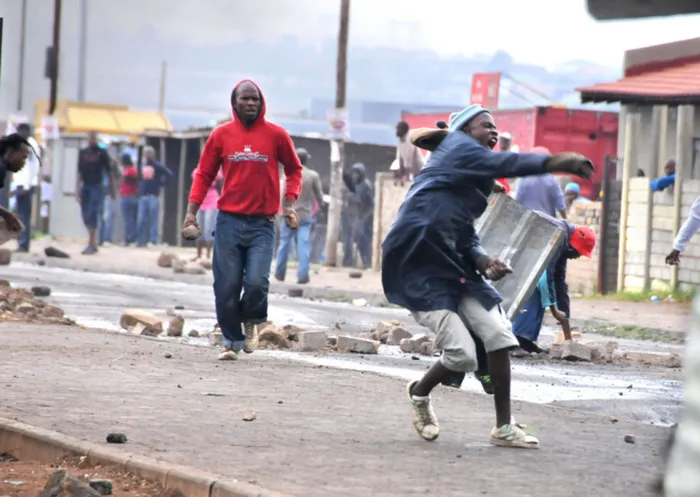Trapped in ‘Satan’s Church’

913 21/03/2012 An angry protester throws rocks at police during a protest in Evaton which turned violent as residents accused a pastor at The Rivers of Living Water church of using witchcraft on children. Picture: Ihsaan Haffejee 913 21/03/2012 An angry protester throws rocks at police during a protest in Evaton which turned violent as residents accused a pastor at The Rivers of Living Water church of using witchcraft on children. Picture: Ihsaan Haffejee
My eyes are stinging and my skin is burning as I sit trapped inside a church surrounded by angry protesters. This is not how I had expected to spend Human Rights Day.
The day starts out peacefully on duty in the newsroom when a contact calls me to say that there is a protest on the go at a church in Evaton.
And so I head out with freelance photographer Ihsaan Haffejee, unaware that I am about to encounter something I have not seen since my days as a schoolboy in the townships.
On Human Rights Day, Sharpeville residents are protesting against the day being commemorated in Soweto, while others in Heidelberg are rioting over service delivery.
But a protest of a different kind is under way in Evaton, with a rather unusual morning church service taking place at the Rivers of Living Waters Church.
Inside the church congregants are singing and dancing while automatic rifle-wielding private security guards are hanging over the church balconies.
The guards are here to provide security for the church because angry protesters, who are accusing the church’s Bishop Stephen Zondo of witchcraft and Satanism, have started to gather outside.
Zondo arrives in a blue-light private security car guarded by heavily armed security guards.
He is quickly escorted into the church where he spends the next three hours preaching.
We arrive and station ourselves near the police, who are close to the gate of the church.
The angry protesters are approaching from three sides, but as soon as they get too close to the church’s property police push them back by firing rubber bullets in their direction.
Enraged, the protesters retaliate by throwing stones, petrol bombs and bottles at the police’s armoured vehicles.
Police then fire a tear gas canister into the growing crowd, but the tactic boomerangs when the wind picks up and blows the gas back in our direction.
I take cover behind a police Nyala as my nasal passages and eyes have started stinging. Police fire another tear gas canister into the crowd. It lands among the protesters, but the fumes come back again, this time sending several police officers and a few journalists running in different directions.
Churchgoers trapped behind the church’s palisade fences are also not spared the biting fumes and rush back inside the church.
I hear a man shouting: “Go to a tap; wash it off with some water!”.
I run toward the stoep of a nearby house with no intention of heeding his advice because I know that water will only worsen the sting of the tear gas on my skin.
Back outside the church I find myself among a throng of police officers and other journalists standing right in front of the protesters’ target: the blue-roofed church which they want to burn.
A huge tent on the church-owned stand across the road has already been burned down the previous night and a man has been shot dead.
I know I have to be cautious as I am standing less than 150m from the angry crowd.
A bird flies over, and I duck, mistaking it for a rock.
Two police Nyalas battle to control the crowd which has now surged forward in a three-pronged attack.
But as police battle to fend off two prongs, a third rushes forward towards the church.
Faced with a rapidly approaching crowd armed with stones and petrol-bombs, a man in civilian clothes wearing a police-issue bullet-proof vest and a uniformed female officer pull their guns out and start firing over the protesters’ heads.
On the other side, flames from home-made petrol bombs lick the sides of the Nyalas as they negotiate their way through rocks and rubble barricades, spewing rubber bullets out at the protesters.
It is a game of cat and mouse, with protesters scattering as the Nyalas approach.
The protesters have worked out how far the Nyalas can go into the township, and then taunt and jeer until the police turn back.
A while later screams emanate from the church and there is a scuffle at the entrance. Churchgoers are beating up a man who they believe is part of the protesting crowd.
He is left with a bleeding nose and mouth and bruises to his arms.
The police’s hands are full, as they try to keep the protesters away from the church and restrain a group of stick- and axe-wielding congregants from heading out into the streets to attack the protesters.
All the while I am trapped with the congregants, caged in by the protesters.
Several vehicles are damaged that day, and there are reports of congregants having been attacked when they leave the church.
It has been a long day. Amid all the shooting and stone-throwing, I finally find Haffejee.
The violence is abating and the situation appears to be calming down, so we decide to leave via the back roads. We drive through some rough wetland before making it safely to the Golden Highway.
Congregants remain trapped in the church until late into the night.
I have covered many violent protests, but this one at the Evaton church has been the most frightening of them all.
Back at the office I look in the mirror. My eyes are red and face parched.
Tomorrow I go back to Evaton.
That’s my job. - The Star